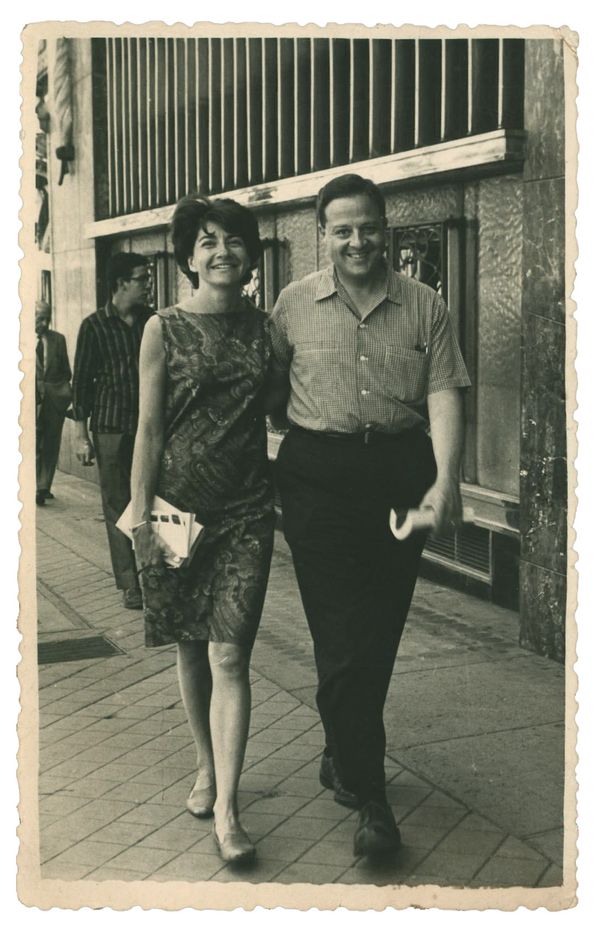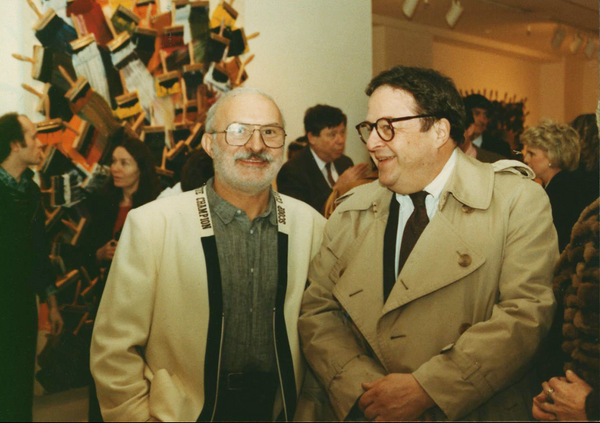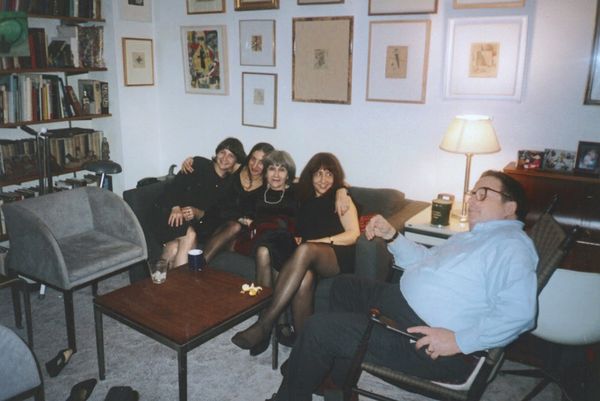The Esman family gathered on a quiet evening, c. early 2000s.
There are three sides to every story. This epic is told by three devoted daughters of Rosa Esman and Aaron H. Esman, MD. They are, from oldest to youngest, as follows:
Susanna (S.)
Marjorie (M.)
Abigail (A.)
Rosa and Aaron Esman assembled an outstanding array of Modern, Post-War, Contemporary, and even African and Pre-Columbian art over the course of their seventy-year marriage. Dr. Esman began collecting art as a reflection of his passion for all of the arts. A voracious reader, as well as a frequent concert and theater goer (Dr. Esman held particular enthusiasm for Mozart, Schubert, and jazz performances), his collecting grew out of an insatiable curiosity for the world and appetite for the creative achievements that enriched it. Those interests guided his collecting activity throughout his life. Rosa was a pioneering publisher of editions, in addition to being a successful gallerist. The couple’s shared passion for art was evident from the early days of their courtship as they visited galleries and museums together. The collection they built over the decades, rich in Modernism, Dada, Russian Constructivism, and American Pop Art, reflects both Mrs. Esman’s career as a gallerist and print publisher and Dr. Esman’s voluminous writings on art, creativity, and the mind during his career as a psychiatrist. To Susanna, Marjorie, and Abigail, they were Mom and Dad. But there was no denying even from the very beginning that their parents were not like the others. They put art at the very center of their lives. And their legacy is astonishing.
This exclusive interview below is the first of three installments featured here in the pages of Phillips Voices. Two more will follow in the coming weeks. For this edition, we focus on prints. Mrs. Esman was a ground-breaking print publisher who initiated portfolios of fine art prints and editions of three-dimensional multiples with the iconic artists of the 1960s and 1970s, including Andy Warhol, Roy Lichtenstein, Donald Judd, Richard Serra, Lee Bontecou, Robert Rauschenberg, Eva Hesse, Tom Wesselmann, Sol LeWitt, Robert Motherwell, Helen Frankenthaler, and others – many of which feature in the sale. In addition, during the 1970s, Rosa joined with art book publisher Harry Abrams to create Abrams/Original Editions, producing portfolios and individual prints by Saul Steinberg, Red Grooms, and others. Her inspired vision, which grew out of the couple’s own desire to collect works by artists they could not otherwise afford, helped pioneer the field of Post-War artists’ editions and multiples.

Rosa and Aaron Esman, Madrid, 1963.
Did your parents personally know many of the artists they acquired?
Susanna: My parents knew most of the Pop artists, and were friendly with them, with Helen Frankenthaler, and several others. They were very close with Arman and with Herbert Ferber. Although they owned works by both Sol and Bob [Lewitt and Rauschenberg] before I met them and my mother had shown Sol's work at her gallery, she (and my father) became much friendlier with him because of my relationship with him, and many of the works of his they own, were gifts from him to them. My parents liked to entertain, so probably the majority of the artists in their collection (certainly the American ones) had been to their house and seen their works there.
Marjorie: Yes, they knew most of them. They were friends with most of the artists in the '60s, I recall dinner parties with Lichtenstein, Wesselmann, Johns, and Frankenthaler. Absolutely Arman, who was a good friend of my father's and that was a relationship that lasted through the decades. They were friendly with most of the people whose works my mother published as part of Tanglewood Press.
Abigail: They knew almost all of them. Arman was a very dear friend, and visited frequently. Frank Stella and my father were especially fond of one another, and though they didn't socialize much at our home, would sit and talk together at parties and events when they did see each other. Our father used to make little geometric drawings, and at one time gave one to Frank. Years later, a museum in Belgium featured "artists' favorite things," and Frank Stella included our father's drawing. Andy Warhol visited a few times in the '60s; I recall one party in particularly which he crashed with his entire entourage. Others they were friends with, or friendly enough with to invite to their home: Herbert Ferber (also a close friend); Kenneth Snelson; Jasper Johns; Tom Wesselmann; Helen Frankenthaler (also a good friend). Our mother was among the first to exhibit Tom Sachs and Vik Muniz, so they were also friendly, though I don't recall either of them visiting the apartment.

Aaron Esman with artist and close friend Arman.
Please share a few anecdotes about your personal relationship with your favorite pieces in the collection.
S: As an adult, my favorite pieces probably were the LeWitts and Mangolds, but as a child I enjoyed it when my friends came over and were shocked by the collection. Several derided the Miró, and said they could do that. I always explained that they hadn't though, and handed them a piece of paper so they could try. Needless to say, they each failed miserably, and usually gave up very quickly.
M: My father taught me how to look at art when, as children, we were traipsed through museums. I recall being repelled by the images of blood and violence in Renaissance paintings, particularly but not exclusively crucifix images. It was he who told us not to look at the images because the painting isn't really about the subject matter, it's about the use of color, perspective, brushstrokes, etc. It took a while for me to understand what he meant, but of course he was right, and it's been a lasting lesson.
A: It relates to a work that is long since sold. For me as a child: Jasper Johns came to dinner once when I was ten. Our mother had told me that he had been working that day at the Museum of The City of New York, which in those days had more than just the one dollhouse, but to me was only about dollhouses. Mustering up my most mature voice, I said to him: "Mr. Johns, I understand you are working with dollhouses." Johns was my favorite of the artists in my parents' collection at the time; the hallway was hung entirely with Jasper Johns prints, of which a double flag and a 0–9 were my particular loves.
"No," said Jasper Johns. "But do you have a dollhouse?"
Yes, I did.
"May I see it?" asked Jasper Johns.
So I took him to see my dollhouse, which he dutifully admired before asking me if the dolls would like an art work from him.
"Yes," I said, "they would."
Was there a particular work in the hallway I liked best? "Yes," I said, "there is. The one with the numbers."
Not long after, an envelope arrived for me from the artist, containing a tiny 0–9 drawing for the dolls. I confess that I have kept custody of it for them ever since. However, on a more general level, as children, our friends were always somewhat awed and confused by the collection. So many things were art that you wouldn't normally associate with "art" as a child in the '50s and '60s. They would point to stuff and ask "Is that art?" "Is that art?"

Rosa and Aaron Esman with Arman.
To your knowledge, were there many artists your mother worked with who were new to printmaking — that she perhaps debuted in the medium?
S: My mother (and Marian Goodman) were the first people to publish contemporary prints, so most of the artists she worked with hadn't done prints before.
M: I don't know, it's an interesting question.
A: Yes. Trying to remember (Oldenburg, I think, and maybe Wesselmann?) but the best source of information on this would probably be the Smithsonian Archive interview. Ditto — and especially — in making multiples, as she was the first person to do that, beginning with Seven Objects in A Box. Marian Goodman and others followed, but this was where Rosa was the true pioneer.
Works on paper were clearly important within your mother's career. How did this manifest in family traditions (as with the holiday greeting cards she made and in other ways)?
S: Painting and drawing were one of my father's hobbies, and it was he who made the holiday cards. I think they purchased works on paper because they were more affordable.
M: I haven't thought about those greeting cards in a long time. They were actually designed by my father. I never thought about her as emphasizing works on paper other than that they may have been more affordable.
In the editions your mother did, did she ever have a hand in shaping the direction of the work?
S: My mother (parents) definitely had insights and strong opinions, but I don't think she shaped the direction of the art works. She had too much respect for the artists to do that.
M: Insights and opinions, absolutely. I was a child when she did those and don't know whether she had a hand in shaping the direction of the work.
A: Yes, and absolutely. She was particularly involved in the creating of the Warhol "Portraits of the Artists" on small plastic boxes, which she acquired by hunting down the manufacturer of the boxes, which were sold at Azuma stores - a popular shop in the '60s and '70s that sold everything from posters to imported wooden boxes to clothes, mostly from Asia. She also worked closely with Roy Lichtenstein on some of the many editions they created together. And the idea of producing editions in the first place was shaped in large part by our parents' desire to own works by artists they couldn't otherwise afford. But "person of many insights and strong opinions" would be a very good way of describing Rosa.
Parts Two and Three of "All for Love of Art" to follow!
Auction Information /
Part of "The Estate of Rosa Esman" will be featured in Phillips Editions New York auction, 21 June, 10am
Location /
432 Park Ave, New York, NY, United States, 10022 (map)
Viewings /
15–21 June
Monday–Saturday, 10am–6pm
Sunday, 12pm–6pm
Recommended Reading
Relax, it’s Summer Editions >
Calder the Draftsman >
